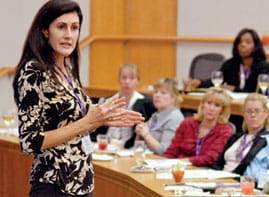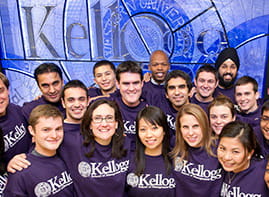During Kellogg visit, music portal visionary shares learning curve behind his entrepreneurial endeavor
5/9/2008 - As the founder of Pandora Radio, Tim Westergren has unlocked the digital music box.
A musician first and foremost, Westergren visited the Kellogg School of Management on May 5 to speak with MBA students and Northwestern University undergraduates about the challenges he has faced in creating the popular streaming radio Web site. His talk was hosted by the new
Kellogg Entrepreneurship Club.
The project has been in the making for the last decade and came about when Westergren was employed as a film producer to create musical scores. Working with the director, they would trade music with each other until they found the right fit for the project. “It was much like a music personality test,” he said.
Westergren wasn’t just playing around though; he has credibility in the music world. A 1988 graduate from Stanford, he studied computer acoustics and recording technology while honing his musical talents. He didn’t know exactly what he wanted to do with music upon graduation, so he worked as a “manny” (male nanny) in California and began performing on tours. “As a musician, I saw how hard it is to make a living,” he said.
When Westergren began a career as a film producer in 1999, he was living in the Bay Area — a time and place conducive to nurturing any “cool idea,” he said, noting that “investor money was flowing like water.” Although he wasn’t sure where he saw the “music personality test” idea going, he believed the Internet’s mainstream ascent could help refine the vision and create some new opportunities.
He applied for and received $1.5 million from an angel investor and soon hired engineers and musicians to build the product. But by mid-2001, the company was quickly running out of money. Two and a half years later, it went bankrupt. Westergren said the company had accrued $1.5 million in salary debt and he had maxed out several credit cards to keep afloat. “It was a bit like gambling. I was pretty far down.”
Yet Westergren and his associates continued to believe in their vision. In 2004, he said they “miraculously” raised $9 million from another venture capitalist in California. In the interim, two significant changes would dramatically impact the business: more than half of households by then had broadband connections — a big advantage for an application based on streaming audio that demands large bandwidth for optimal operation. Also, a portion of the illegal peer-to-peer digital music landscape had been cleaned, with many sites being shuttered while others, such as Apple’s iTunes Music Store, presented a straightforward — and legal — model for collecting and storing digital media files.
The concept was rebranded as Pandora and launched in late 2005 as a consumer-facing database. Since then, only word-of-mouth among those in the music industry and online has accelerated its growth curve. Today Pandora, which means “all gifted” in Greek, has 12 million registered listeners and more than 125 employees. He said 70 percent of the site’s artists are not affiliated with a major record label, which increases the exposure of lesser-known or up-and-coming musicians.
But how does it work? Westergren said his original idea of producing a tool that offers a “musical fingerprint” for a director is Pandora’s inspiration. That effort, now called the Music Genome Project, includes a team of 50 musician-analysts. Songs are evaluated by them one attribute at a time, cross-analyzed and matched up with similar tunes. For example, if a listener enjoys Amy Winehouse’s “Back to Black,” that person may like Nicole Willis and the Soul Singers’ “Feeing Free;” both share modern R&B styling, minor key tonality and other features. More than 400 attributes are assessed for each song and then plugged into a mathematical algorithm that clusters songs together.
The result is an individualized streaming playlist. If a listener disagrees with what Pandora generates, he can simply tell it to skip the song, or not to play it again. And that’s a much different model than what classic radio has been.
“We want to be the biggest radio across all mediums in the world,” Westergen said. He said that he sees IP-delivered radio as the way of the future, especially as the Internet becomes more integrated with cellular service, which makes Pandora nearly 100 percent portable.
However, Westergren told the Kellogg audience, the biggest advantage he sees in Pandora is its ability to expose listeners to what’s happening at all levels of the music industry. Such exposure combined with an active listening experience may one day give musicians a viable career. After launching less than three years ago and already earning half a percent of the market share of all radio, Westergren said Pandora is on its way to that goal.






